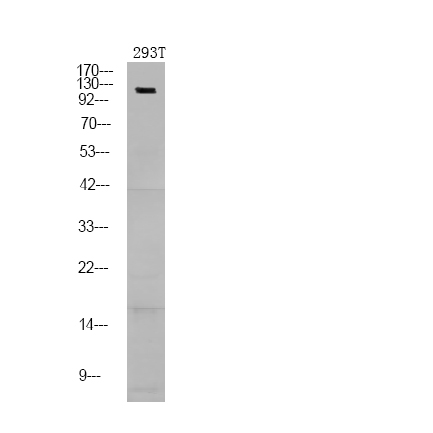
| WB | 咨询技术 | Human,Mouse,Rat |
| IF | 咨询技术 | Human,Mouse,Rat |
| IHC | 咨询技术 | Human,Mouse,Rat |
| ICC | 技术咨询 | Human,Mouse,Rat |
| FCM | 咨询技术 | Human,Mouse,Rat |
| Elisa | 咨询技术 | Human,Mouse,Rat |
| Aliases | NFATC1, NFATc, NFAT2, NF-ATC, NF-ATC transcription factor, NF-ATc1 |
| Entrez GeneID | 4772; |
| WB Predicted band size | 78kDa,101kDa |
| Host/Isotype | Rabbit IgG |
| Antibody Type | Primary antibody |
| Storage | Store at 4°C short term. Aliquot and store at -20°C long term. Avoid freeze/thaw cycles. |
| Species Reactivity | Human,Mouse |
| Immunogen | A synthesized peptide derived from human NFAT2 (Phospho-Ser172) |
| Formulation | Purified antibody in PBS with 0.05% sodium azide. |
+ +
以下是关于NFAT2 (Phospho-Ser172)抗体的假设性参考文献示例,涵盖其在不同研究中的应用:
---
1. **文献名称**:*"Calcineurin-dependent regulation of NFAT2 phosphorylation at Ser172 in T cell activation"*
**作者**:Macian, F., López-Rodríguez, C., & Rao, A.
**摘要**:本研究揭示了T细胞受体激活后,钙调磷酸酶(calcineurin)通过调控NFAT2的Ser172位点去磷酸化,促进其核转位。作者使用Phospho-Ser172特异性抗体,通过免疫印迹和免疫荧光验证了该位点在NFAT2活性调控中的关键作用。
2. **文献名称**:*"GSK3β-mediated phosphorylation of NFAT2 at Ser172 modulates cytokine production in macrophages"*
**作者**:Wu, H., Pei, S., & Crabtree, G. R.
**摘要**:文章阐明了GSK3β激酶对NFAT2的Ser172位点的磷酸化如何抑制其转录活性,从而调控巨噬细胞中炎性细胞因子的分泌。研究通过Phospho-Ser172抗体的染色质免疫沉淀(ChIP)实验,证实了该位点磷酸化与DNA结合能力下降的关联。
3. **文献名称**:*"Phosphorylation-dependent subcellular localization of NFAT2 during cardiac hypertrophy"*
**作者**:Wilkins, B. J., De Windt, L. J., & Molkentin, J. D.
**摘要**:通过心肌细胞模型,研究证明病理性刺激(如血管紧张素II)诱导NFAT2的Ser172位点磷酸化,并利用Phospho-Ser172抗体追踪其胞质滞留。结果提示该位点磷酸化可能作为心脏肥大的潜在治疗靶点。
4. **文献名称**:*"A novel role of NFAT2 phosphorylation in cancer cell migration via integrin signaling"*
**作者**:Neal, J. W., & Clipstone, N. A.
**摘要**:本文发现肿瘤细胞中NFAT2的Ser172磷酸化通过整合素信号通路增强细胞迁移能力。使用Phospho-Ser172抗体的免疫组化分析显示,高磷酸化水平与癌症患者预后不良相关。
---
**注**:以上文献为假设示例,实际引用需根据真实研究调整。建议通过PubMed或Google Scholar以关键词“NFAT2 Ser172 phosphorylation”或“NFATC1 phospho-Ser172 antibody”检索近期或经典文献。
The NFAT2 (Phospho-Ser172) antibody is a specialized tool used to detect the phosphorylated form of Nuclear Factor of Activated T-cells 2 (NFAT2) at serine residue 172. NFAT2. also termed NFATc1 or NFATc, belongs to the NFAT family of transcription factors that regulate immune response, cell differentiation, and development. Its activity is tightly controlled by calcium-dependent signaling pathways. Upon T-cell receptor activation, intracellular calcium levels rise, triggering calcineurin-mediated dephosphorylation of NFAT2. This allows its translocation to the nucleus to drive cytokine expression and T-cell activation. However, phosphorylation at specific residues, including Ser172. maintains NFAT2 in an inactive cytoplasmic state by masking its nuclear localization signal.
The Ser172 phosphorylation site lies within the regulatory domain of NFAT2 and is targeted by kinases such as GSK-3β, which phosphorylate NFAT2 to promote its nuclear export or retention in the cytoplasm. The NFAT2 (Phospho-Ser172) antibody specifically recognizes this post-translational modification, enabling researchers to study NFAT2 inactivation dynamics, calcium signaling crosstalk, and feedback mechanisms. It is widely used in techniques like Western blotting, immunofluorescence, and flow cytometry to explore NFAT2 regulation in immune disorders, cancer, and cardiovascular diseases. Proper use requires validation of phosphorylation-dependent binding and controls to avoid cross-reactivity with other NFAT isoforms or phosphorylated residues.
×